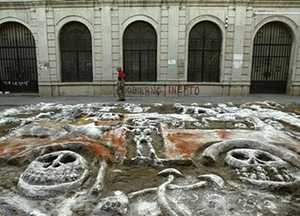 |
 |
 |
 Editorials | Issues | November 2006 Editorials | Issues | November 2006  
Holiday has New Meaning in Oaxaca
 S. Lynne Walker - Copley News S. Lynne Walker - Copley News


| | A man walks at near a sand sculpture in downtown Oaxaca, Mexico, Wednesday, Nov. 1, 2006 during Day of the Dead celebrations. (AP/Guillermo Arias) |
Oaxaca City, Mexico – Day of the Dead is a special celebration for the people of Oaxaca, a holiday filled with bright orange flowers and pungent incense that draws people together with remembrances of deceased friends and family members.

But this year, the annual celebration is tinged with anger and resentment.

A five-month occupation of the city by a leftist group and the killings of at least a dozen of the group's supporters have divided Oaxaca.

“Innocent people have died,” Maricela Velasco, a 39-year-old preschool teacher, said yesterday as she watched several women construct a flower-laced altar to commemorate those who died during the fight for control of the city.

“We are not going to forget this. We will not forget our dead.”

As the city struggled to get back to normal after federal police seized control of its colonial center from protesters on Sunday, residents ventured out of their homes to prepare for the elaborate Day of the Dead celebrations today and tomorrow that have made the city internationally famous.

Business owners cautiously opened their doors. Federal police relaxed their cordon around the shady main plaza. City workers swept up debris and painted over graffiti scrawled by a group known as the Popular Assembly of the People of Oaxaca, or APPO, that has demanded the resignation of Oaxaca Gov. Ulises Ruiz.

For the first time in months, Ruiz's supporters – mostly middle-class residents and members of his Institutional Revolutionary Party – took to the streets to back the beleaguered governor.

“The APPO does not represent all of the people in Oaxaca,” said Manuel Santiago, 37, a junior high school teacher. “They are a group of delinquents.”

Yesterday, Santiago joined hundreds of people in a march that sparked a confrontation between Ruiz's supporters and APPO sympathizers who slapped and insulted each other.

“We are still panicked because we are afraid they will do something to us,” said María Jiménez, a 54-year-old homemaker who participated in the march.

“We want the police to stay here for six months, a year. If the police leave, they (the APPO protesters) will come back,” she said.

The question dividing the state's residents is whether Ruiz should be forced to resign.

“The idea is ineffective, not viable and illegal,” Heliodoro Díaz, the governor's top Cabinet minister and one of his closest political allies, said in an interview yesterday.

“The removal of the governor will not resolve the problem of the APPO or the teachers strike,” he said. “It will create an environment of anarchy and impunity.”

Preschool teacher Elisa Machado said Oaxaca's residents believe that environment already exists. “We feel helpless,” she said.

Machado looked at a sign hanging over the altar commemorating APPO's dead. It read, “I gave my blood for telling the truth to the people.”

“Normally, we celebrate these days with happiness,” she said, her eyes filling with tears. “Today, we are sad.” | 
 | |
 |



